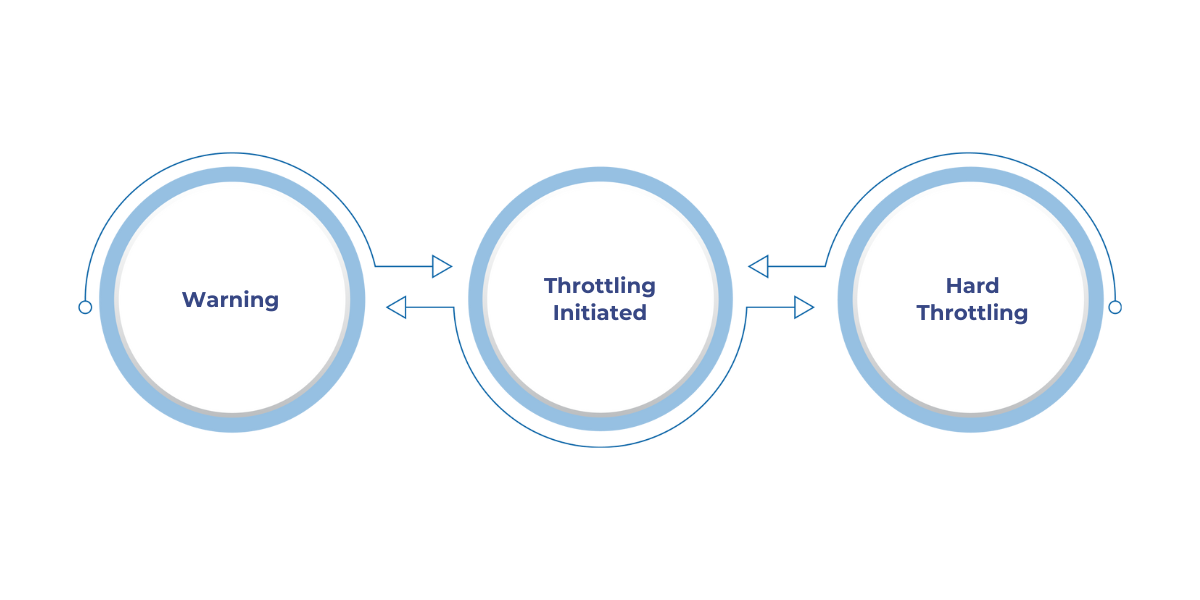

Throttling in Microsoft Fabric occurs when operations exceed compute unit limits, slowing down performance and potentially impacting service reliability. This typically happens when resource thresholds are surpassed, affecting both backend processes and user-facing applications.
For businesses, this can lead to delays in data processing, impacting decision-making in real-time analytics or disrupting transactional systems in industries like finance and retail.
In this blog, we cover the causes of throttling, strategies for mitigation, and effective management techniques.
Balancing performance and reliability in Microsoft Fabric requires precise management of resource usage to avoid throttling while maintaining optimal system performance. Over-optimizing for performance can push resources beyond set limits, triggering throttling.
Therefore, businesses need to implement strategies that optimize both aspects without compromising one for the other.

Fabric smoothing involves managing workloads to reduce throttling by balancing resource use across tasks. It helps ensure system stability, especially under high-demand conditions.
Spreading workloads across multiple instances prevents any single instance from becoming overloaded.
For example, distributing data processing tasks across clusters ensures no one node is overwhelmed, avoiding performance bottlenecks.
Prioritizing critical operations ensures they are processed first. In a financial platform, for example, real-time transactions are prioritized over batch processes, ensuring smooth and timely transaction processing.
Managing latency ensures that less important ones do not delay high-priority tasks. For instance, during peak traffic, prioritizing checkout processes over inventory updates helps maintain a smooth customer experience.
Techniques such as task scheduling or resource reservation can be used to allocate resources effectively, ensuring that critical tasks are completed on time.
Now, let’s look at the stages and triggers of throttling to better understand how to respond to resource overloads before they impact system performance.

Throttling in Microsoft Fabric occurs in distinct stages, each triggered by specific system conditions designed to protect the platform's performance and stability.
These stages are designed to manage resource consumption, prevent system overloads, and ensure that critical operations are prioritized.
At this stage, the system monitors resource usage and signals that it's nearing the allocated threshold. This is a proactive measure, providing businesses with an early warning so they can adjust workloads or scale resources to avoid throttling.
For example, an alert may trigger when compute usage is approaching 80% of the allocated capacity, giving administrators time to adjust and prevent further strain.
Once resource usage exceeds the set threshold, throttling is initiated. At this point, non-critical operations are intentionally slowed or delayed to free up resources for essential tasks.
For example, batch processing tasks might be paused to ensure real-time analytics continue running smoothly. This stage helps prevent more severe throttling events by reducing the load before it impacts critical systems.
Background jobs are rejected, prioritizing immediate, mission-critical tasks over less time-sensitive processes. This ensures that critical business functions, such as transaction processing or real-time data updates, continue uninterrupted.
Also Read: Guide to Data Security and Privacy in Microsoft Fabric
Effective management and monitoring of throttling are essential for smooth operations. Here’s how to ensure your system remains stable with real-time monitoring and alert systems.
Effective management and monitoring of throttling are vital for ensuring system stability and optimal performance within Microsoft Fabric.
By proactively monitoring resource usage, businesses can prevent throttling and maintain seamless operations, ensuring that systems function at their best even during high-demand periods.
Real-Time Monitoring
Alert Systems
Analytics Integration
To further minimize throttling, let’s discuss the top strategies businesses can implement to ensure resources are managed efficiently and consistently.

To minimize the impact of throttling and ensure consistent user experience, businesses can implement various strategies that address resource consumption and optimize system performance.
The following strategies focus on dynamically adjusting resources, reducing workload strain, and anticipating potential bottlenecks.
Auto-scaling adjusts resources dynamically based on real-time demand. By configuring auto-scaling policies that scale resources up or down depending on metrics like CPU or memory usage, businesses can ensure sufficient capacity during high demand and reduce costs when demand decreases.
Example: During high-traffic events, such as sales, auto-scaling ensures that additional servers are provisioned, preventing overload and throttling.
Optimizing database queries reduces load on compute units. Techniques such as indexing, query restructuring, and optimizing joins help decrease the complexity and execution time of queries, minimizing the strain on resources.
Example: Streamlining queries in an analytics dashboard reduces database load and prevents throttling during peak reporting hours.
Data caching stores frequently accessed data in memory, reducing repetitive database queries and lowering resource consumption. Caching ensures that data is served quickly, without overloading backend systems.
Example: Caching weather data in a forecast app prevents frequent API calls, easing the load on compute units and reducing the risk of throttling.
Regular load testing simulates high-demand scenarios to identify system weaknesses before they cause throttling. By stress-testing the system, businesses can optimize performance and prevent resource bottlenecks.
Example: A social media platform uses load testing to simulate millions of concurrent users, ensuring the system performs well without throttling during a major product launch.
Now, let’s explore how businesses can handle overages and carry forward unused capacity within Microsoft Fabric to optimize resources and reduce unnecessary costs.
When businesses exceed their allocated resources, it results in overages, which can lead to extra costs or throttling. Microsoft Fabric provides tools to manage these overages, allowing unused capacity to be carried forward, helping businesses optimize resources and reduce unnecessary expenses.
Below is a breakdown of key strategies and technical details for handling overages:
Also Read: A Step-by-Step Guide on Migration Strategies from Azure API for FHIR
Microsoft Fabric throttling is a critical mechanism that helps maintain system stability, but if not properly managed, it can significantly impact performance and user experience. Understanding the stages and triggers of throttling is key to preventing slowdowns and delays.
By implementing strategies such as auto-scaling, optimizing queries, utilizing data caching, and setting up proactive monitoring, businesses can mitigate the impact of throttling and maintain smooth system operation.
At WaferWire, we specialize in optimizing cloud environments, including Microsoft Fabric, for better performance and efficiency.
Contact us today to learn how we can help you manage throttling, scale resources effectively, and maintain smooth operations.
Q: What happens during the "hard throttling" stage in Microsoft Fabric?
A: During hard throttling, any excess operations beyond the resource limits are either paused or terminated. This ensures that critical business functions, like transaction processing or real-time updates, continue without disruption.
Q: How can businesses set up alert systems to avoid throttling issues in Microsoft Fabric?
A: Businesses can configure automated alerts based on resource usage thresholds. These alerts notify administrators when usage nears capacity, allowing for quick corrective actions such as scaling or redistributing workloads before throttling occurs.
Q: Can Microsoft Fabric's auto-scaling work with on-premises data systems?
A: While auto-scaling in Microsoft Fabric primarily applies to cloud environments, integration with on-premises systems is possible with hybrid cloud solutions. This ensures resource allocation is managed seamlessly across cloud and on-premises data systems.
Q: What is the significance of data lineage tracking in preventing throttling?
A: Data lineage tracking helps organizations understand data flow and transformations across systems. It ensures that inefficient data processes are identified and optimized, preventing overuse of resources that could lead to throttling.
Q: How does Microsoft Fabric’s integration with Azure improve security and prevent throttling?
A: Azure integration enables centralized authentication, encryption, and role-based access control, ensuring secure data access and protection. This reduces the risk of unauthorized access, helping prevent security-related throttling and system strain.

